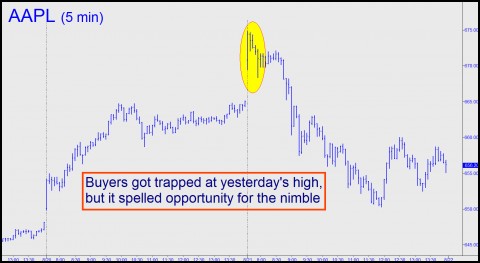Looking for a cheap, low-risk way to play a $600 stock that can lurch and careen all over the place on any day? We’re talking about Apple, of course, and you needn’t fear the stock if you use puts and calls judiciously and follow some simple rules. Yesterday, for instance, Rick’s Picks suggested calendar-spreading some far-out-of-the-money puts to establish a moderately bearish position. Although we’ve been quite bullish on the stock and remain so, it may have gotten ahead of itself with the nearly 20% gains achieved so far in August. Accordingly, when AAPL spiked yesterday morning to a new all-time high of 675, it seemed like a great opportunity to buy some put calendar spreads at the 620 strike, well below current levels. Specifically, we recommended buying the December 620 – October 620 put spread eight times for $14, or $1400 per. This strategy is not outright bearish on Apple; it merely leverages the possibility that the stock is overdue for a nasty
correction. Incidentally, we elected not to buy put options outright simply because, in the 38 years we’ve been trading puts and calls, we have yet to come across a single person who has profited over time by buying naked puts (or calls). Take it from us: spread-trading is the only way to go.
On this particular trade, the ideal outcome would be for Apple shares to fall slowly to around $620 ahead of the October 19 date on which the October puts we are short expire. Those puts would be theoretically worthless with the stock trading at or above $620, but the December 620 puts we bought as a hedge against them would have increased in value to as much as $3300. (That’s how much at-the-money put options with two months left on them are selling for now.) Our profit per spread at that point, after buying the October puts back for as little as fractional pennies on the dollar, would be about $1900 (i.e., $3300 less the $1400 originally paid). There is risk, as well, of Apple turning strong again, but not as much as you might think. For instance, if the stock were to rally 80 points in the next week or so, to around 735, our spread would still be worth about $8. That would imply a loss per spread of $600, but it would be reduced by nearly half by gains on September 615 puts we shorted as a kicker (more on that immediately below). At that point, we’d be holding some very cheap puts at the 620 strike with nearly four months left on them.
Naked-Short ‘Kicker’
Concerning the “kicker” mentioned above, those who bought the calendar put spreads when Apple was peaking near $675 in the opening minutes of the session got lucky because the stock subsequently plummeted $25. (An article posted at ZeroHedge noted that the dollar loss thereof equaled the entire value of Sony Corporation). The plunge that trapped bulls at yesterday’s fleeting, opening-bar high was wind in our sails, allowing the sale of a few extra “naked” September 615 puts @ 6.20 against the spreads we owned. Although these short puts carry lethal risk if the stock should collapse, a merely nasty decline might be expected to raise the value of our put spread by more than the rise in the September 615 put (which we shorted in a 1:2 ratio versus the spreads). And if AAPL should simply noodle around, perhaps with a mildly downward bias, between now and September expiration, the September 615 puts will decay to nothing, effectively reducing the $14 cost basis of our spreads by about $300 apiece, to $11.
All of this is less complicated than it sounds, as evidenced by the fact that numerous subscribers reported fills in the Rick’s Picks chat room. If you want to join the fun in real-time, click here for a free trial subscription.


https://sphotos-b.xx.fbcdn.net/hphotos-prn1/526292_413597548699231_998422323_n.jpg a pretty good political cartoon